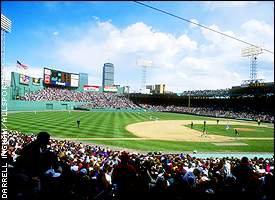BOSTON -- They meet in the most historic district of the most historic city in the nation, on the second floor of an old brick building down the street from Fanueil Hall and the Union Oyster House, directly above the relocated Green Dragon, the famed tavern in which American patriots once convened to throw back beverages and throw out Brits.
|  | | Fenway Park is as much a draw for fans as the team that plays there. |
"That's where the Revolution was plotted," Dan Wilson said, sitting in his office above the Green Dragon.
The irony is not lost on Wilson, research director for the fan-based group Save Fenway Park. For two years, members of the nonprofit organization have been coming together every week to organize, strategize and fight what they consider the good fight: the salvation of the oldest ballpark in baseball.
The current owners of the Boston Red Sox want to demolish Fenway and replace it with a $665 million stadium down the street that will feature more seats, more luxury boxes, more concessions, more merchandise-sales areas, in-stadium team offices, better clubhouse facilities and a parking garage -- all the amenities that can be found at modern-day ballparks.
Nothing is certain, however, except that this might be the most important offseason in Red Sox history. Last month, amid concerns over whether what would be the most expensive ballpark ever built in the country could in fact pay for itself, the Red Sox were put up for sale by John Harrington, trustee of the Yawkey Trust, which has controlling interest in the team.
The new owners -- there are many groups lining up to bid -- will likely determine the fate of Fenway. Harrington has said as much. But in the meantime, he continues to prepare its death certificate, pushing forward with the current proposal for a new ballpark, which if approved would likely enhance the value of the franchise he is trying to sell.
"The framework is all there," Harrington said. "The pieces are there. Now it comes down to getting to the table and negotiating."
Already, the state of Massachusetts has agreed to contribute $100 million to the project. Still, the deal could easily fall apart. Many city council members are on record as opposing the plan, which calls for the city to kick in $212 million. Environmental cleanup issues loom. Land-acquisition costs could soar, especially if business owners on the proposed site file suit. Experts say the $665 million price tag could easily grow by hundreds of millions, making it even more difficult for the Red Sox to line up private financing to pay for their share.
Against this backdrop, Wilson's group and its 500 contributors ask a question both pragmatic and sentimental: Why not just renovate Fenway?
It's a question worth asking before the steamroller of progress levels another historic ballpark.
"This is a battle for baseball's soul," Wilson said. "If we can't beat the corporate takeover of baseball here, we won't be able to stop it anywhere."
With the departure of the Detroit Tigers from Tiger Stadium after the 1999 season, Fenway Park and Wrigley Field are the last of the early 20th century ballparks that helped make the game America's pastime. Built in 1912 (Wrigley went up in 1914) and made to fit into an existing neighborhood, Fenway and its elegant lines have been the subject of enough books to fill a small library.
The place where Babe Ruth once tossed fastballs, where Ted and Yaz once played the carom, where fans are right on top of the action and everything seems green -- that place became the architect's model for Baltimore's Oriole Park at Camden Yards, the first of the modern, retro-style ballparks that sprang up in the '90s. It is a cruel twist of fate that the stadium boom Fenway inspired is now threatening its demise.
Oddly, age is on Fenway's side. The older it gets, the more beloved it gets.
|
Fenway attendance
|
|
Decade
|
Total
|
Avg./year
|
|
1912-19
|
3.6M
|
450,823
|
|
1920-29
|
3.3M
|
326,899
|
|
1930-39
|
4.8M
|
482,117
|
|
1940-49
|
9.6M
|
963,382
|
|
1950-59
|
11.3M
|
1,131,197
|
|
1960-69
|
11.5M
|
1,150,469
|
|
1970-79
|
18.2M
|
1,815,588
|
|
1980-89
|
19.6M
|
1,955,117
|
|
1990-99
|
23.3M
|
2,325,372
|
|
2000-
|
2.6M
|
2,586,024
|
The Red Sox drew 2,586,024 fans in 2000, best in club history. Despite the highest average ticket prices in baseball and a team that failed to make the playoffs, the 33,871-seat ballpark was regularly sold out.
In fact, the Red Sox have drawn more than two million fans each year since 1986 (except the 1994 strike season), after doing that only three times in the previous 74 years.
Average attendance has grown every decade since the 1920s, even though the team has not won a World Series since Ruth was in uniform.
Along the way, Fenway has become something of a national treasure. The living baseball museum is the No. 1 tourist attraction in Massachusetts, with 35 percent of those in attendance on any given night coming from outside the state. It is a must-see for any former Little Leaguer who, now all grown up, is in town for the night on business.
In their push for a new stadium, the Red Sox have gained the support of the elites that usually get behind efforts like these around the country: the mayor, key state legislators and corporate leaders, the editorial boards of the two largest newspapers (Boston Globe, Boston Herald), the sports columnists, Major League Baseball commissioner Bud Selig, and current and former players.
On the other side, to some degree, are those who vote with their behavior at the box office.
"It all comes down to whether the fans will say no," Wilson said. "And the fans will say no."
Jamie McGourty, 24, of South Boston, is not as confident as Wilson.
"I think it will end up going through no matter what because politicians in Boston always get their way," said McGourty, holding a cup of beer while standing in the concourse behind home plate during a September game. "It's sad because here I am and I still get that same electrifying feeling I did when I first walked in here 18 years ago as a boy."
Fenway supporters are not going away. If anything, the Save Fenway Park coalition is proving to be one of the most effective stadium-opposition groups to come along in sports, in part because their driving goal is to save something (a ballpark) rather than prevent something (new taxes). Members held rallies twice a week outside the entrance to the ballpark, passing out bumper stickers. They lobby politicians and send literature to reporters. The group's Web site is regularly updated and it sends out bi-monthly newsletters.
|
Join the debate
|
|
The future of Fenway Park will be determined by people in Boston, where the city council is now weighing a funding package that demolish the old ballpark and make way for a new stadium down the street. So far, politicians have heard mostly from local concerns.
Missing in the debate has been the voice of fans around the country. You can share your opinion on whether Fenway should be preserved, renovated or demolished by contacting members of the city council, Mayor Tom Menino, Speaker of the House Tom Finneran and Senate president Tom Birmingham.
You can also contact the Red Sox and Save Fenway Park, the fan-based group, to share your thoughts.
|
The core of the group consists of a couple dozen volunteers. Many of them are young professionals -- lay people such as Erika Tarlin, a Cambridge librarian who put in 40 hours a week over the summer; Jeffrey Harris, a planner with the National Trust for Historic Preservation and a lifelong Sox fan; and Wilson, a lawyer who specializes in small businesses and appreciates great architecture.
Although still in debt, Save Fenway Park has raised $40,000 this year, up from $20,000 last year and $7,000 in 1998, according to Wilson. Donations and $25 membership dues make up the bulk of the funds.
In August, the group produced its strongest challenge yet to the notion that Fenway must go. A team of national experts in ballpark architecture, historic preservation, structural engineering and other fields were brought to Boston for an intensive, 10-day design symposium to address the question: Can Fenway be modernized to meet the needs of a 21st-century baseball team?
The plans they produced say the answer to that question is yes. Those plans will be explored this week in an ESPN.com series.
The Red Sox have not offered comment on the proposals. They say they have ruled out the possibility that Fenway can be renovated. But no doubt the club is taking notes. Serious-minded fans are gathering above the Green Dragon to save the Green Monster, and rarely if ever has a case been made so forcefully, with so much precision, that a historic venue should be saved.
"We don't want the 14th replica of Camden Yards," Wilson said.
They want something rare and just as audacious, a thoughtfully renovated classic.
Tom Farrey is a Senior Writer for ESPN.com. He can be reached at tom.farrey@espn.com. | |
ALSO SEE
Chart: Comparing Fenway plans
Fenway Park timeline
Quotes about Fenway Park
Pick the Best Ballpark
 |



